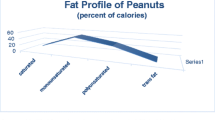Abstract
Chemical characterizations of oils and meals from the wild sunflower species Helianthus petiolaris Nutt and their comparison with those from cultivated sunflower (H. annuus) were performed. Seeds from indigenous populations of H. petiolaris were harvested in Argentina in different years. The analytical parameters studied were as follows: (i) FA profile, PV, p-anisidine value, oxidative stability, phosphorus and phospholipid content, tocopherols, polar compounds, and waxes in the extracted oils; and (ii) moisture, ash, crude fiber, metals, sugars, urease activity, starch, protein, available lysine, neutral detergent fiber, acid detergent fiber, lignin, gross energy, and amino acid content in the residual meals. The products from wild sunflower seed, which yielded 27–30% oil by solvent extraction, showed some characteristics similar to the commercial products. Nevertheless, the oil had lower quality and stability owing to the high unsaturation levels and lower concentrations of antioxidant components, and the meal had a lower protein content. The phospholipid content was significantly lower than in industrial crude sunflower oils. Most of the important parameters in the meal such as available lysine, gross energy, and digestibility compared favorably with those for cultivated sunflower meals. The results showed the potential for using these meals for animal feed.
Similar content being viewed by others
References
Seiler, G.J., and L.H. Rieseberg, Systematics, Origin, and Germplasm Resources of the Wild and Domesticated Sunflower, in Sunflower Technology and Production, edited by A.A. Schneiter, American Society of Agronomy, Crop Science Society of America, and Soil Science Society of America, Madison, WI, 1997, pp. 21–65.
Seiler, G.J., Progress Report of the Working Group of the Evaluation of Wild Helianthus Species for the Periol 1991–1993, Helia 17:87–92 (1994).
Dorrell, D.G., and E.D.P. Whelan, Chemical and Morphological Characteristics of Seeds of Some Sunflower Species, Crop Sci. 18:969–971 (1978).
Seiler, G.J., and M.E. Brothers, Oil Concentration and Fatty Acid Composition of Achenes of Helianthus Species (Asteraceae) from Canada, Econ. Bot. 53:273–280 (1999).
Seiler, G.J., Oil Concentration and Fatty Acid Composition of Achenes of North American Helianthus (Asteraceae) Species, Econ. Bot. 48:271–279 (1994).
Seiler, G.J., Forage Quality of Selected Wild Sunflower Species, Agron. J. 78:1059–1064 (1986).
Standard Methods for the Analysis of Oils, Fats and Derivatives, 7th edn., edited by C. Paquot and A. Hautfenne, International Union of Pure and Applied Chemistry, Blackwell Scientific, Oxford, 1992.
Official Methods and Recoimmended Practices of the American Oil Chemists' Society, 4th edn., edited by D. Firestone, AOCS Press, Champaign, 1993.
Carelli, A.A., M.I.V. Brevedan, and G.H. Crapiste, Quantitative Determination of Phospholipids in Sunflower Oil, J. Am. Oil Chem. Soc. 74:511–514 (1997).
Carelli, A.A., L.M. Frizzera, P.R. Forbito, and G.H. Crapiste, Wax Composition of Sunflower Seed Oils, 79:763–768 (2002).
Dobarganes, M.C., M.C. Pérez-Camino, and G. Márquez-Ruiz, High-Performance Size Exclusion Chromatography of Polar Compounds in Heated and Non-heated Fats, Fat. Sci. Technol. 90:308–311 (1988).
Official Methods of Analysis of the Association of Official Analytical Chemists, 15th edn., edited by K. Helrich, Association of Official Analytical Chemists, Arlington, VA, 1990.
Marais, J.P., J.L. De Wit, and G.V. Quicke, A Critical Examination of the Nelson-Somogyi Method for the Determination of Reducing Sugars, Anal. Biochem. 16:373–381 (1966).
Chemical and Biological Methods for Grain and Forage Sorghum, edited by V.Y. Guiragossian, S.W. Van Scoyoc, and J.D. Axtell, Department of Agronomy-International Programs in Agriculture-Purdue University, West Lafayette, IN, 1979.
Tilley, J.M., and R.A. Terry, A Two-Stage Technique for the in vitro Digestion of Forage Crops, J. Brit. Grassland Soc. 18: 104–111 (1963).
Booth, V.H., Problems in the Determination of FDNB-Available Lysine, J. Sci. Food Agric. 22:658–666 (1971).
Chang, J., R. Knecht, and D.G. Braun, Amino Acid Analysis at the Picomole Level, Biochem. J. 199:547–555 (1981).
Padley, F.B., F.D. Gunstone, and J.L. Harwood, Occurrence and Characteristics of Oils and Fats, in The Lipid Handbook, edited by K.D. Gunstone, J.L. Harwood, and F.B. Padley, Chapman & Hall, London, 1994, pp. 47–223.
Brevedan, M.I.V., A.A. Carelli, and G.H. Crapiste, Changes in Composition and Quality of Sunflower Oils During Extraction and Degumming, Grasas Aceites 51:417–423 (2000).
Crapiste, G.H., M.I.V. Brevedan, and A.A. Carelli, Oxidation of Sunflower Oil During Storage, J. Am. Oil Chem. Soc. 76:1437–1443 (1999).
Piva, G., Nutritional Value of Sunflower Seed and Sunflower Meal for Livestock Animals, in Proceedings of the 13th International Sunflower Conference, International Sunflower Association Paris, France, 1992, Vol. 2, pp. 1611–1625
Park, C.S., G.D. Marx, Y.S. Moon, D. Wiesenborn, K.C. Chang, and V.L. Hofman, Alternative Uses of Sunflower, in Sunflower Technology and Production, edited by A.A. Schneiter, American Society of Agronomy, Crop Science Society of America, and Soil Science Society of America, Madison, WI, 1997, pp. 765–808.
Suncica, B., Variability in Protein and Aminoacid Contents in Different Sunflower Inbreeds, in Proceedings of the Xth International Sunflower Conference, International Sunflower Association, Surfers' Paradise, Australia, 1982, pp. 218–220.
Author information
Authors and Affiliations
Corresponding author
About this article
Cite this article
Perez, E.E., Carelli, A.A. & Crapiste, G.H. Chemical characterization of oils and meals from wild sunflower (helianthus petiolaris nutt). J Amer Oil Chem Soc 81, 245–249 (2004). https://doi.org/10.1007/s11746-004-0890-y
Received:
Accepted:
Issue Date:
DOI: https://doi.org/10.1007/s11746-004-0890-y




